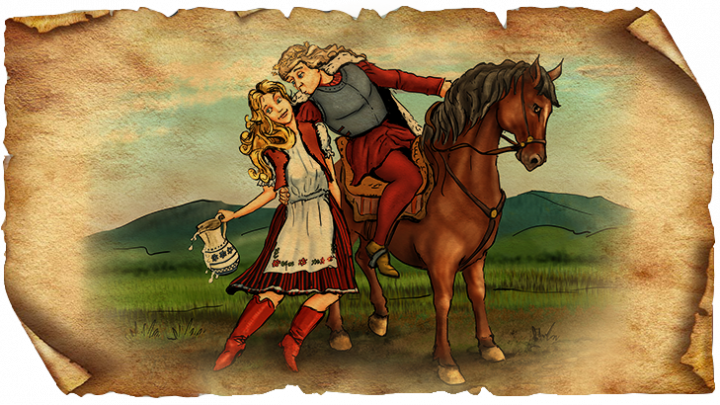Tales from Trei Sate / Hármasfalu

On the right bank of the river Kis-Küküllő / Small Tarnava, Hármasfalu / Trei Sate, situated in the vicinity of Erdőszentgyörgy / Sângeorgiu de Pădure and Makfalva / Ghindari, was established in 1950 by merging three villages – Csókfalva / Cioc, Atosfalva / Hotești and Székelyszentistván / Ștefănești.
The mother village was Székelyszentistván. Here is situated the Reformed church built in 1880, but according to tradition, there was an ancient church here in the time of King St. Stephen. For example, there are many beliefs about the places at the boundaries of the settlement, for example, it is said about the caverns of the site called Virgó that gold is veritably produced there that is regularly harvested and taken away by mysterious aliens. The boundary part called Keme Bükke got its name from a Hungarian leader, and according to folk tradition, there was a fortress on the Kozmáné Hill. On the pole of the castle a white flag was fluttering in peacetime, but if it was a red flag on the fortress, it was considered as a danger signal - the men ran with their weapons to defend the castle and the village. The people of the village Szentistván consider that II. Ferenc Rákóczi also often hunted in this region. He set up a camp several times on the top of the border, this is why it is still called the Prince's Meadow.
The origin of the other village, Csókfalva, is related to King Matthias. The King once passed through the village accompanied by a cortege, and before he could drink, his populous escort, his soldiers all agitated the good-quality water of the village wells. The king remained almost thirsty, but a beautiful peasant girl, whose house was avoided by the soldiers, came to help him. She brought clean water from there in an ornate jug for King Matthias, who, thanks to her, kissed both of her cheeks - the girl became Matthias's maid of honour, and the village was named Csókfalva. The same story appears in Szentistván, but according to legend, King St. Stephen himself kissed a girl, this is how the village got its name. According to another story, the founders of Csókfalva could not decide whether to establish a village or city. As the majority said "it should be only a village", the settlement was founded as a village.
In the third village, Atosfalva, we find a belief related to the Prince of Rákóczi: during a campaign, the prince planted a lime tree (as the people call it: zádokfa) in the village, which is said to be still there today. According to Balázs Orbán, the modern Atosfalva was formed by the fact that six families fled from the plague epidemic to Szentistván - so it was first called Hatosfalva, and later its name was formed by omitting its initial letter.
The Unitarian Church built in 1798 in Csókfalva is one of the most beautiful sights, and in Székelyszentistván, it is worth visiting the Barátosi Mansion House.
Walking around the beautiful mansion houses, through the lively little streets, they can remind us of the kissing stories associated with the settlement. If we get tired, we can relax in the shade of beautiful lime trees in a princely way.
The mother village was Székelyszentistván. Here is situated the Reformed church built in 1880, but according to tradition, there was an ancient church here in the time of King St. Stephen. For example, there are many beliefs about the places at the boundaries of the settlement, for example, it is said about the caverns of the site called Virgó that gold is veritably produced there that is regularly harvested and taken away by mysterious aliens. The boundary part called Keme Bükke got its name from a Hungarian leader, and according to folk tradition, there was a fortress on the Kozmáné Hill. On the pole of the castle a white flag was fluttering in peacetime, but if it was a red flag on the fortress, it was considered as a danger signal - the men ran with their weapons to defend the castle and the village. The people of the village Szentistván consider that II. Ferenc Rákóczi also often hunted in this region. He set up a camp several times on the top of the border, this is why it is still called the Prince's Meadow.
The origin of the other village, Csókfalva, is related to King Matthias. The King once passed through the village accompanied by a cortege, and before he could drink, his populous escort, his soldiers all agitated the good-quality water of the village wells. The king remained almost thirsty, but a beautiful peasant girl, whose house was avoided by the soldiers, came to help him. She brought clean water from there in an ornate jug for King Matthias, who, thanks to her, kissed both of her cheeks - the girl became Matthias's maid of honour, and the village was named Csókfalva. The same story appears in Szentistván, but according to legend, King St. Stephen himself kissed a girl, this is how the village got its name. According to another story, the founders of Csókfalva could not decide whether to establish a village or city. As the majority said "it should be only a village", the settlement was founded as a village.
In the third village, Atosfalva, we find a belief related to the Prince of Rákóczi: during a campaign, the prince planted a lime tree (as the people call it: zádokfa) in the village, which is said to be still there today. According to Balázs Orbán, the modern Atosfalva was formed by the fact that six families fled from the plague epidemic to Szentistván - so it was first called Hatosfalva, and later its name was formed by omitting its initial letter.
The Unitarian Church built in 1798 in Csókfalva is one of the most beautiful sights, and in Székelyszentistván, it is worth visiting the Barátosi Mansion House.
Walking around the beautiful mansion houses, through the lively little streets, they can remind us of the kissing stories associated with the settlement. If we get tired, we can relax in the shade of beautiful lime trees in a princely way.
